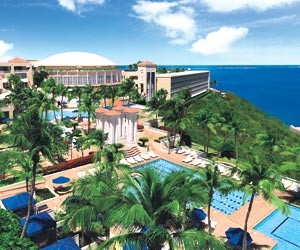While the business environment is not as robust as it was back in the pre-recession days, resorts—which bore much of the brunt of the meetings industry’s recent challenges—appear to be bouncing back.
This is in part, according to group sales managers in several Southern resorts, because the perception issue—the so-called AIG Effect—that afflicted resorts so harshly during the recession has finally faded away.
“It’s no longer dictating site selection,” says Marty Couch, director of group sales at Kiawah Island Golf Resort on Kiawah Island, S.C. “What used to be a concern for the luxury segment has definitely subsided; it doesn’t come up in conversation like it used to.”
That’s good news for Robert Filipelli, managing director of sales & marketing for the El Conquistador Resort & Conference Center in Las Croabas, Puerto Rico.
“Just because a group was flying over water, attendees were thought to be going on a boondoggle,” Filipelli says. “That has turned around.”
Alex Gregory, director of sales and marketing for Sea Island Resorts in Sea Island, Ga., says the increase in short-term bookings that resorts are experiencing is a sign that business is picking up.
“We’re still seeing dynamic business, where the booking window is continuing to shorten,” he says. “A lot of times that is being dictated by the CEO and whether or not he’ll commit to holding a meeting.”
Kiawah’s Couch agrees. In February he filled a two-day, 150-room hole in his April 2012 calendar—a booking window of under 60 days.
“Companies are again holding face-to-face meetings,” he says.
Value Proposition
So what is the ROI in bringing meetings to resorts? “Value” is the operative word, says Penny Jackson, group sales manager for the Sandestin Golf and Beach Resort in Destin, Fla.
“Everybody is looking for value now and planners are being asked to show ROI and justify their meetings,” she says.
Jackson is seeing shorter stays, which requires the property to eliminate travel time for off-site activities, she says.
“They don’t have a lot of time to spend on excursions and activities, so convenience is a key,” Jackson says.
Consequently, she contends, resorts work because everything a group needs—meeting space, dining options and activities—is all in one spot.
“You get cost savings because you don’t have to book multiple venues and pay for transportation to shuttle attendees off-property,” she notes.
Resorts also allow attendees to do pre- and post-event stays.
“They can add in a little vacation time without incurring more travel expenses,” Jackson says. “Sandestin is always a great location for something like that because you don’t want to just get here, meet, and then just go home. You want to relax and enjoy the resort as well.”
Filipelli says that at the El Conquistador, the value is evident.
The resort’s meeting space—over 100,000 square feet—and location overlooking the Atlantic Ocean gives him selling bonuses, he says.
“We provide a lot of different offerings for different types of meetings and groups,” Filipelli says, “and that makes our destination work.”
Safe Havens
Safety and security considerations can work in a resort’s favor because they are self-contained. Sea Island, for example, hosted the G8 Summit in 2004 and has established a reputation as a safe and secure meeting place—an increasingly important offering to some groups.
“These days there are a lot of concerns about doing business in a secure environment,” Gregory says. “We offer safety and security.”
Groups that are willing to book off-peak can find value at resorts.
Off-peak at the Sandestin—located on the Florida Panhandle—is from November through February; exactly opposite of South Florida.
“They can get the same rooms for a little more than half of what they would have to pay during the summer,” Jackson says.
The fall and spring shoulder seasons—although more expensive than the winter—still represent good value, she notes.
Who’s going?
While resorts have generally recovered from the dark days of 2008-2010, the meetings mix seems to have evolved.
For example, Sea Island continues to attract meeting business from the financial/insurance and technology sectors, among others, while the El Conquistador has broadened its focus.
“We’ve always been a business resort,” Filipelli says.
But, Filipelli says the El Conquistador has learned it must diversify its meeting clients to be successful. According to Filipelli, the 2008 crash came at a bad time for the El Conquistador: “We had just finished a big renovation and were primed to go after top-end meetings, but those meetings just dried up.”
Some of those markets are showing increased strength, but now the El Conquistador is reaching out to alternate markets as well. The hotel has amped up efforts to attract association business.
Sometimes what gets lost when meeting at a resort is just that—holding the meeting.
But just because a meeting is being held in a beautiful, relaxing location doesn’t mean there will be too many distractions for attendees to concentrate, Filipelli says.
“I think most meeting attendees are pretty good at focusing on the business at hand,” he says. “Then they have time to head outside and enjoy everything a resort has to offer.”
Michael Bassett, a freelance journalist, has been to his share of resort meetings.






